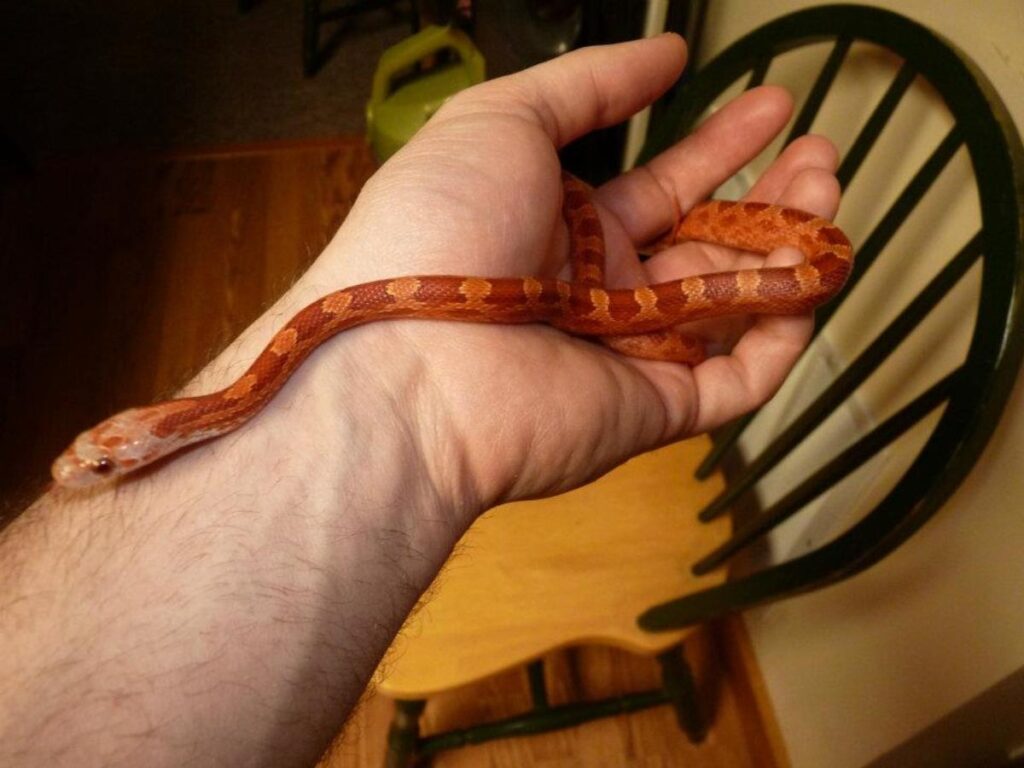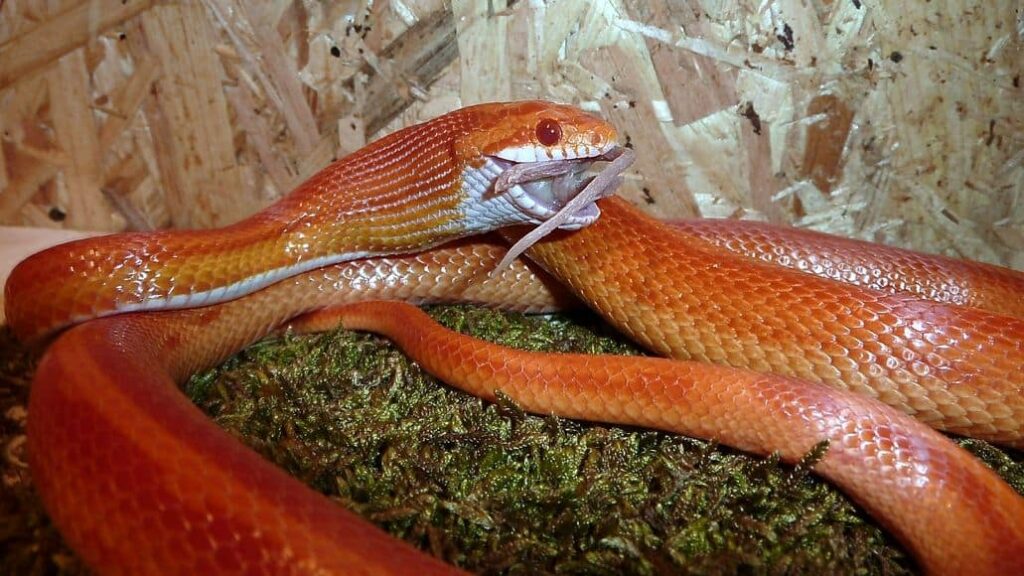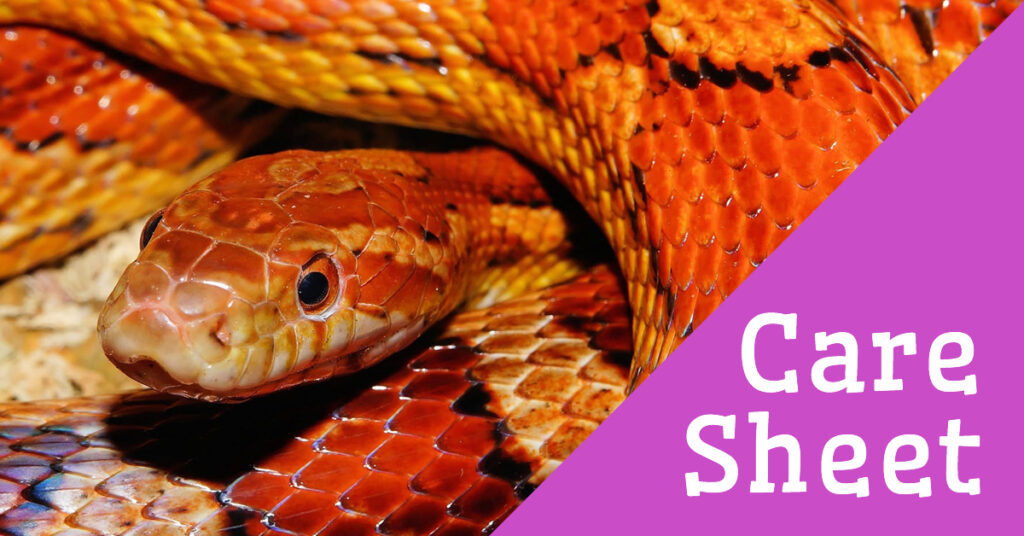When we talk about ornamental snakes most people will immediately think of corn snakes. Not only because of the beauty of diverse colors and unique pattern variations. They have been bred for thousands of generations, and although they are common pets, corn snakes play an important role in the reptile world. The article How To Care For Corn Snakes will introduce you more clearly to how to care for this snake.
Box of corn snakes
According to the requirements of the shelter box of most foreign breeders, they will place two shelters at the two ends of the cage with different warm and cool temperature ranges, so that the snake can choose a comfortable residence and best for its health. In Vietnam alone, most of us use a shelter, and this does not appear to have had a significant negative effect on the snake.

The best advice the author has ever received when it comes to burrows suitable for almost all snakes is to make burrows out of tree trunks in the shape of an “L”. Because a den with two entrances makes snakes feel more secure, and you don’t need to change a new den as the snake gets bigger.
Because corn snakes belong to the species of snakes with thigmotactic type behavior (contact locomotion). That is, they keep most of the body area in contact with the ground, and environmental surfaces such as the ceiling and sides of the cave, the higher the contact area to feel more secure.
Lights and heating
Reptiles are cold-blooded animals, so they absorb heat through the living space around them. In the wild, snakes will bathe in heat energy to support digestion and internal organs. If they find it just enough or too hot, they will actively seek out a cool or shaded place to radiate heat, this is called temperature regulation.
The most suitable temperature for corn snakes is between 30-21C. Heat can be provided by a heating pad or a heater with a lamp guard. The heat pad should only span about ½ or 1/3 of the cage floor so the snake can freely regulate its temperature as it feels necessary, and if an accident occurs, the heat won’t burn the snake too badly.

The thermometer recommended to be used to monitor the house temperature is always maintained at a safe level. Heating lights are also common tools, but make sure that the distance between the lights and the floor of the cage is at the right height to give off a reasonable and safe amount of heat for the snakes.
And make sure that the heat source from the lamp will not come into direct contact with the snake without a protective barrier. Because snakes will not be aware of whether the heat they are exposed to will cause them to squirm or not. A lamp guard will ensure that the corn snake won’t get in an accident from the heat of the heater.
The problem with heating lights is that the lights must be on 24/7 to maintain a stable temperature of the cage, and constant lighting will stress the snakes. It is recommended that you imitate the morning time of a normal day, so the heat pad will do this more reasonably. If you use a heating pad, besides, an energy-saving lamp to light up and increase the aesthetics of the cage can be added.
Water
All reptiles require the constant use of clean water. Water should be stored in a tray that is just the right size and weight so that the snake does not easily topple the water out of the cage. The water tray also plays an important role during the snake’s shedding time, when you will often see snakes spending time bathing in the tray.
Always remember that when you see signs of dirty water, change it as quickly as possible. If you see snakes defecating in the tray, disinfect the tray before adding new water. This is a follow-up to How To Care For Corn Snakes.
Humidity
Corn snakes don’t require a certain amount of air humidity, but they will be grateful for a humidifying mist at each of their molts to aid in a faster and more efficient process. For example, you can add moist scum in the shelter when the snake’s eyes start to cloud. And look at the snake’s skin, if it sheds a piece of its skin, it means that it has a good level of moisture.
If the skin peels into many pieces and gets stuck on the snake’s body, it means the moisture is too low. As long as there is no mold growth in the cage, the humidity in the cage does not reach a level that is harmful to snake health. Make sure you don’t let the humidity in the cage stay too high as this will cause the corn snakes to get respiratory infections.
Food
Young snakes will eat pinky mice. If they won’t eat frozen rats, you should try feeding the snake live pinky rat. Usually, they will change their bait after a while getting used to the smell of food. The best feeding schedule is 5-7 days/time for small snakes.

When a new snake comes back, a strange animal, you should give a small portion of food, which can cause stress in the digestive process. After the snake gets used to the environment, it is strongly recommended to increase the diet, but do not give too much to make the snake full.
Corn snakes eat mice with the same size as their mouth, the size of the prey should be equal to the size of the head or half to make it easier for the snake to swallow the prey. Rats are the main food of corn snakes. This is a follow-up to How To Care For Corn Snakes.
Clean the barn
If the barn is lined with aspen, it is easy to clean up dirty spots because the waste is usually sucked dry at a certain point. You can clean the cage a few days after the snake goes to the bathroom, or you can replace the entire cage with a new one if the cage starts to get dirty or too smelly. The cleaning time will depend on the size of the cage, the size of the snake’s meals and digestion, the feeding cycle, etc.
As a general rule, corn snakes aren’t as messy as king snakes, and their droppings are a bit dry, rather than scattered around the coop. This is a follow-up to How To Care For Corn Snakes.
Reproduction
Corn snakes can reproduce very well in artificial environments. Corn snakes should reach the required age as well as a good body shape and requirement health risks during delivery, such as having their eggs removedand. The recommended minimum requirements for female snakes to reproduce is at least 3 years old, 1m long, 300 grams in weight. This is a follow-up to How To Care For Corn Snakes.
Hibernation
Here is your advice to get the highest rate of mating success. The best hibernation period for female snakes is 8 to 10 weeks. The temperature needs to be above-recommended and maintained continuously until the temperature is gradually raised again after the above recommended hibernation period. Corn snakes are not fed during this time, but clean water should always be available.
Mating
In the wild, corn snake mating season is usually in March so this they s a good time to pair your females for mating. Let them stay in the same cage for a few weeks, if successful mating you will be in the time to lay eggs of female snakes. This is a follow-up to How To Care For Corn Snakes.
Conclusion
Hopefully, the article How To Care For Corn Snakes will provide useful information for you.

